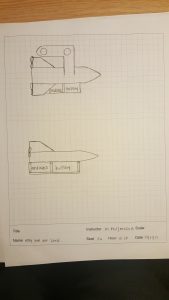Below are the Team’s Individual sketches followed by the final sketch that the Team settled on after deliberation.
Rob McEwan Sketch 2/31/17
Rob’s design was similar to Ryan’s because the topic of the “X-Wing” design was discussed previously. A sleek outer shell to cover the Arduino and battery provided the model with good aerodynamics when traveling in order the increase the efficiency of the system. Furthermore, the propellers on the rear would provide maximum forward thrust as well as weight distribution while on the track. If the model shell is not created with the light-weight material then the purpose of aerodynamics increasing the efficiency would be pointless.
Stephanie Smithson Sketch 2/31/17
Stephanie’s design was a two level AEV model, made from the plastic bases provided along with front plates and rear dual tail wings. The two plate model was designed in order to protect the Arduino and battery which would be placed in between them with the front plates guarding from the front. The dual tail wings are intended to provide horizontal balance when the AEV is traveling along the rail system. When considering the Mission Concept Review, the protective design supports the intentions to protect valuable assets. The dual plate model, however, would increase the weight of the AEV and reduce its efficiency.
Ryan DeVine Sketch 2/31/17
Ryan’s individual design was inspired by the “X-Wing” fighter jet. Given the situation is given in the Mission Concept review, this design was fitting. The AEV model was built upon the large plastic platform and features Both the Arduino and Battery concealed under the decorative “X-Wing” shell on top of the platform. The sleek design of the “X-Wing” would provide an optimal aerodynamic shape. Both motors were placed on the rear of the design which will provide a good point of thrust. The AEV design is aerodynamic which supports the mission concept review goal to provide an AEV that performs the tasks efficiently. A good aerodynamic structure will make for less air resistance when traveling. Accordingly, it also must be noted that the design would hinder the efficiency of the system if a lightweight construction material is not used to create the body.
Holly van der Lans Sketch 2/31/17
Holly’s design features a cylindrical body with a distinct point at the front of the model. This is intended to maximize the efficiency of the model in order to achieve the goals of the Mission Concept Review. Also, both motors are placed at the back of the design to maximize forward thrust. The Arduino and Battery are carried underneath the base. When considering this design, light weight materials must be used to create the cylindrical body in order to maximize the efficiency of the AEV.
Final Team Sketch after Lab 3 2/31/17
The final design is an X-wing model that has as few adaptations applied to it. The main issue with the X-wing model, considering the Mission concept review, is its weight, which hinders its ability to be energy efficient. The team considered abandoning the idea of the X-Wing design, but due to its aesthetic appeal, and its relation to the theme of the mission, they decided to compromise. The team will construct the body and wings of the AEV with high quality, very light weight material instead of the original dense plastic. This will both make the body of the AEV aerodynamic while not sacrificing the energy efficiency due to its weight. All other aspects of the model currently have not been changed.
This is the SolidWorks model the team made before the servo brake design was thought of for use. This design is exactily like the final design, just without the servo brake.





